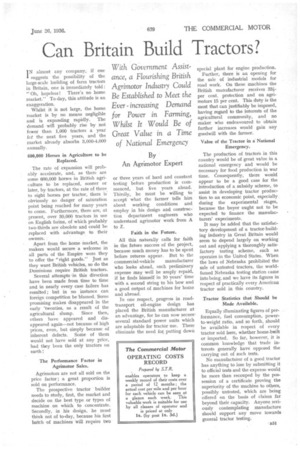Can Britain Build Tractors?
Page 73

If you've noticed an error in this article please click here to report it so we can fix it.
With. Government Assistance, a Flourishing British Agrimotor Industry Could Be Established to Meet the Ever -increasing Demand for Power in Farming, Whilst It Would Be of Great Value in a Time
of National Emergency
By An Agrimotor Expert
IN almost any company, if one suggests the possibility of the large-scale building of farm tractors in Britain, one is immediately told : "Oh, hopeless ! There's no home market." To-day, this attitude is an exaggeration.
Whilst it is not large, the home market is by no means negligible and is expanding rapidly. The demand will probably rise by not fewer than 1,000 tractors a year let the next five years, and the market already absorbs 3,000-4,000 annually.
600,000 Horses in Agriculture to be Replaced.
The rate of expansion will probably accelerate, and, as there are some 600,000 horses in British agriculture to be replaced, sooner or later, by tractors, at the rate of three to eight horses per tractor, there is obviously no danger of saturation point being reached for many years to come. Furthermore, there are, at present, over 30,000 tractors in use on English farms, of which probably two-thirds are obsolete and could be replaced with advantage to their owners.
Apart from the home Market, the makers would secure a welcome in all parts of the Empire were they to offer the "right goods." Just as they want British vehicles, so do the Dominions require British tractors.
Several attempts in this direction have been made from time to time and in nearly every case failure has resulted ; but in no instance can foreign competition be blamed. Some promising makes disappeared in the early 'twenties, as a result of the agricultural slump. Since then, others have appeared and disappeared again—not because of high prices, even, but simply because of inherent defects. Some of them would not have sold at any price, had they been the only tractors on earth I The Performance Factor in Agrimotor Sales.
Agrimotors are not all sold on the price factor ; a great proportion is sold on performance.
The prospective tractor builder needs to study, first, the market and decide on the best type or types of machine on which to concentrate. Secondly, in his design, he must. think not of to-day, because his first batch of machines will require two
or three years of hard and constant testing before production is commenced, but five years ahead. Thirdly, he must be willing to accept what the farmer tells him about working conditions and employ in his design and construction department engineers who understand agrirnotor work from A to Z.
Faith in the Future.
All this naturally calls for faith in the future success of the project, because much money has to be spent before returns appear. But to the commercial-vehicle manufacturer who looks ahead, such preliminary expense may well be amply repaid, if he finds himself in 10 years' time with a second string to his bow and a good output of machines for home and abroad.
In one respect, progress in roadtransport oil-engine design has placed the British manufacturer at an advantage, for he can now secure. several standard power units which are adaptable for tractor use. These eliminate the need for putting down special plant for engine production.
Further, there is an opening for the sale of industrial models for road work. On these machines the British manufacturer receives 333per cent, protection and on agrimotors 15 per cent. This duty is the most that can justifiably beimposed, having regard to the interests of the agricultural community, and no maker who endeavoured to 'obtain further increases would gain any goodwill with the fanner.
Value of the Tractor in a National Emergency.
The production of tractors in this country would be of great value in a national emergency and would be necessary for food production in war time. Consequently, there would appear to be a good case for the introduction of a subsidy scheme, to assist in developing tractor production to an economic point, especially. during the experimental stages, because the buyer ought not to be expected to finance the manufacturers' experiments.
It may be added that the satisfactory development of a tractor-building industry in Great Britain would seem to depend largely on working out and applying a thoroughly satisfactory testing scheme, such as operates in the United States. When the laws of Nebraska prohibited the sale of untested tractors, the worldfamed Nebraska testing station came into being, and we have its figures in respect of practically every American tractor sold in this country.
Tractor Statistics that Should be Made Available.
Equally illuminating figures of performance, fuel consumption, powerto-weight ratio, and so forth, should be available in respect of every tractor sold here, whether home-bttilt or imported. So far, however, it is common knowledge that trade interests generally have opposed the carrying out of such tests.
No manufacturer of a good tractor has anything to lose by submitting it to official tests and the expense would be more than recouped by the possession of a certificate proving the superiority of the machine to others, possibly untested, which are being offered on the basis of claims far beyond their capacity. Anyone seriously contemplating manufacture should support any move towards general tractor testing.












































































































































